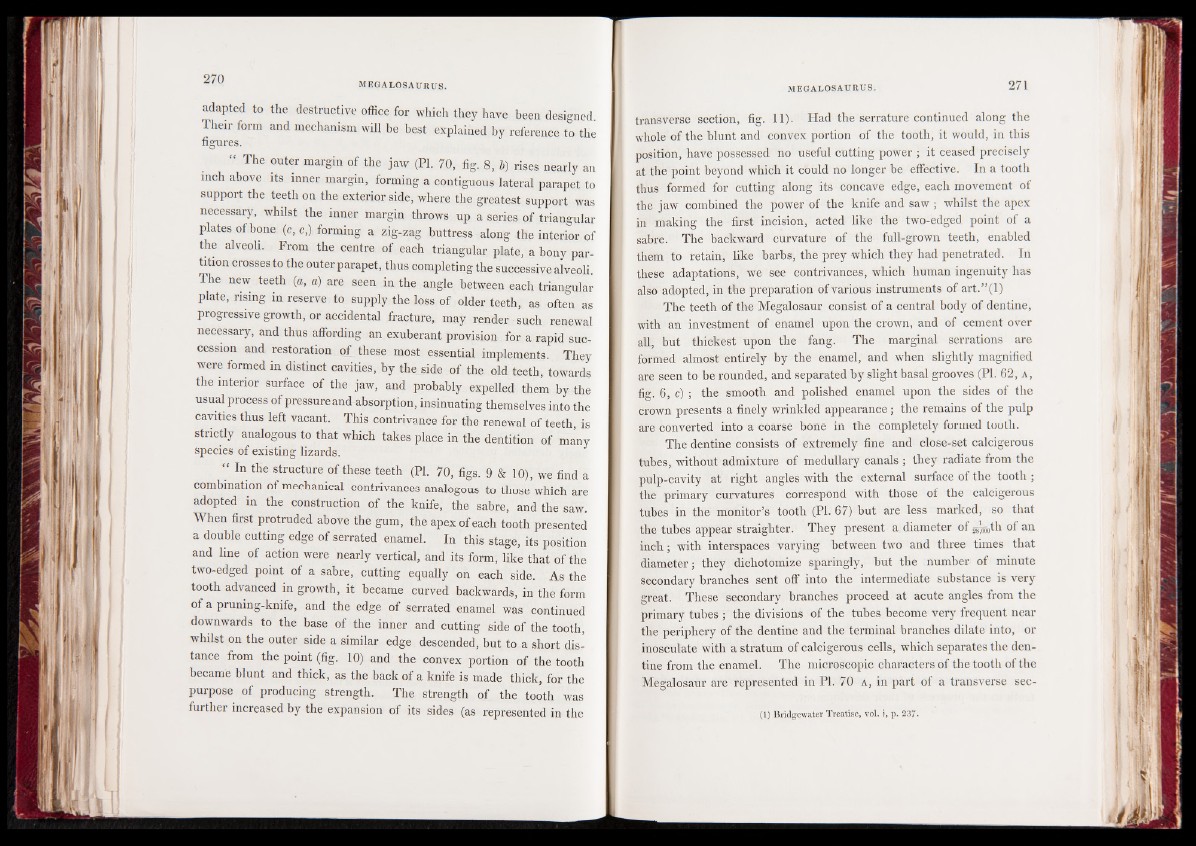
adapted to the destructive office for which they have been designed.
Their form and mechanism will be best explained figures. by reference to the
“ The outer margin of the jaw (PI. 70, fig. 8, b) rises nearly an
inch above its inner margin, forming a contiguous lateral parapet to
support the teeth on the exterior side, where the greatest support was
necessary, whilst the inner margin throws up a series of triangular
plates of hone (c, c,) forming a zig-zag buttress along the interior of
the alveoli. From the centre of each triangular plate, a bony partition
crosses to the outer parapet, thus completing the successive alveoli.
The new teeth (a, a) are seen in the angle between each triangular
plate, rising in reserve to supply the loss of older teeth, as often as
progressive growth, or accidental fracture, may render-such renewal
necessary, and thus affording an exuberant provision for a rapid succession
and restoration of these most essential implements. They
were formed in distinct cavities, by the side of the old teeth, towards
the interior surface of the jaw, and probably expelled them by the
usual process of pressure and absorption, insinuating themselves into the
cavities thus left vacant. This contrivance for the renewal of teeth, is
strictly analogous to that which takes place in the dentition of mJny
species of existing lizards.
| In the structure of these teeth (PI. 70, figs. 9 & 10), we find a
combination of mechanical contrivances analogous to those which are
adopted in the construction of the knife, the sabre, and the saw.
When first protruded above the gum, the apex of each tooth presented
a double cutting edge of serrated enamel. In this stage, its position
and line of action were nearly vertical, and its form, like that of the
two-edged point of a sabre, cutting equally on each side. As the
tooth advanced in growth, it became curved backwards, in the form
of a pruning-knife, and the edge of serrated enamel was continued
downwards to the base of the inner and cutting side of the tooth,
whilst on the outer side a similar edge descended, but to a short distance
from the point (fig. 10) and the convex portion of the tooth
became blunt and thick, as the back of a knife is made thick, for the
purpose of producing strength. The strength of the tooth was
further increased by the expansion of its sides (as represented in the
transverse section, fig. 11). Had the serrature continued along the
whole of the blunt and convex portion of the tooth, it would, in this
position, have possessed no useful cutting power ; it ceased precisely
at the point beyond which it could no longer he effective. In a tooth
thus formed for cutting along its concave edge, each movement of
the jaw combined the power of the knife and saw; whilst the apex
in making the first incision, acted like the two-edged point of a
sabre. The backward curvature of the full-grown teeth, enabled
them to retain, like barbs, the prey which they had penetrated. In
these adaptations, we see contrivances, which human ingenuity has
also adopted, in the preparation of various instruments of art.”(l)
The teeth of the Megalosaur consist of a central body of dentine,
with an investment of enamel upon the crown, and of cement over
all, but thickest upon the fang. The marginal serrations are
formed almost entirely by the enamel, and when slightly magnified
are seen to be rounded, and separated by slight basal grooves (PI. 62, a ,
fig. 6, c) ; the smooth and polished enamel upon the sides of the
crown presents a finely wrinkled appearance; the remains of the pulp
are converted into a coarse bone in the completely formed tooth.
The dentine consists of extremely fine and close-set calcigerous
tubes, without admixture of medullary canals ; they radiate from the
pulp-cavity at right angles with the external surface of the tooth ;
the primary curvatures correspond with those of the calcigerous
tubes in the monitor’s tooth (PI. 67) but are less marked, so that
the tubes appear straighter. They present a diameter of ggjfoth of an
inch; with interspaces varying between two and three times that
diameter; they dichotomize sparingly, but the number of minute
secondary branches sent off into the intermediate substance is very
great. These secondary branches proceed at acute angles from the
primary tubes ; the divisions of the tubes become very frequent near
the periphery of the dentine and the terminal branches dilate into, or
inosculate with a stratum of calcigerous cells, which separates the dentine
from the enamel. The microscopic characters of the tooth of the
Megalosaur are represented in PI. 70 a , in part of a transverse sec-
(1) Bridgewater Treatise, vol. i, p. 237-